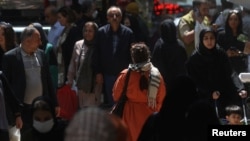
Welcome back to The Farda Briefing, an RFE/RL newsletter that tracks the key issues in Iran and explains why they matter. To subscribe, click here.
I'm RFE/RL correspondent Golnaz Esfandiari. Here's what I've been following during the past week and what I'm watching for in the days ahead.
The Big Issue
Iranian police on April 15 began to enforce new measures to identify and punish women who fail to comply with the Islamic dress code, including the mandatory hijab.
Police said surveillance cameras will be used to monitor public spaces for women not wearing the head scarf, and offenders will receive a warning via SMS. Repeated offenders could face hefty fines and lose access to mobile-phone and Internet services, the authorities said.
Police say they have sent thousands of text messages in recent days to alleged offenders, including to business and car owners. Drivers have been warned that they could have their vehicles seized if they or any passengers violate the hijab law.
Why It Matters: In response to the new measures, some Iranian women have posted photos and videos of themselves in public without the hijab, in a direct challenge to the authorities.
The authorities have intensified efforts to enforce the hijab as more women flout the law. Women have been emboldened by the nationwide antiestablishment protests that erupted in September following the death of 22-year-old Mahsa Amini soon after she was arrested by the morality police for allegedly violating the hijab law. During the demonstrations, women and girls removed and burned their head scarves.
"Good morning to everyone, except [police chief Ahmadreza Radan] and his cameras," a young woman wrote on Twitter on April 15, posting a selfie without the hijab.
Atash Shakarami, the aunt of Nika Shakarami, a teenage girl who was killed in the deadly crackdown on the protests, also posted a photo of herself without a head scarf.
What's Next: The hijab law is likely to remain a source of tension between the clerical establishment and women who are fed up with state interference in their daily lives.
Despite renewed warnings and fresh measures by the authorities, women have continued to defy the hijab law. Even a small number of men have flouted the Islamic dress code by appearing in public in shorts.
Stories You Might Have Missed
An association representing the families of those killed in Iran's downing of a Ukrainian commercial plane over Tehran in 2020 has criticized the verdicts issued by the Iranian judiciary against the alleged perpetrators as a "show trial." On April 16, Iran said it had sentenced 10 members of the armed forces to prison on charges of involvement in the downing of flight PS752. In a statement, the association of the victims' families said the Iranian judiciary did not pursue the main perpetrators and commanders of the crime.
An Iranian academic group said more than 400 students had been suspended or expelled in the wake of recent antiestablishment protests. The Union Council of Iranian Students said on April 13 that 435 students had been hit with disciplinary measures that were carried out through an illegal and security-driven process. In recent weeks, there have also been several reports of university professors being fired or suspended for accompanying protesting students.
What We're Watching
Iranian President Ebrahim Raisi threatened Israel with destruction during a ceremony marking Army Day on April 18.
His comments came hours after Israeli Prime Minister Benjamin Netanyahu said Iran "must be prevented from arming itself with nuclear weapons," in reference to Western fears that Tehran is building an atomic weapon.
Why It Matters: Raisi's warning comes as tensions between Iran and Israel have spiked in recent weeks.
Suspected Israeli air strikes in Syria killed two members of Iran's Islamic Revolutionary Guards Corps (IRGC) on March 31. Tehran vowed to avenge their deaths.
Meanwhile, The Wall Street Journal on April 14 reported that Ismail Qaani, the commander of the Quds Force, the IRGC's overseas operations arm, held a series of clandestine meetings with the leaders of Palestinian militant group Hamas and Lebanon's Hizballah to coordinate attacks against Israel.
That's all from me for now. Don't forget to send me any questions, comments, or tips that you have.
Until next time,
Golnaz Esfandiari
If you enjoyed this briefing and don't want to miss the next edition, subscribe here. It will be sent to your inbox every Wednesday.





